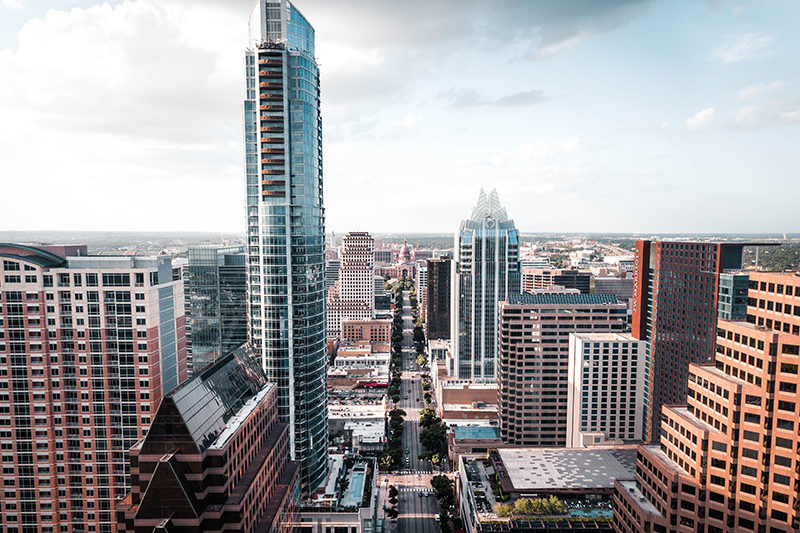Understanding Austin’s Ambitious Transportation Plans
By Alyx Wilson
Reporting Texas

Downtown Austin, Texas. Photo by Jeremy Banks/Unsplash
If you’re like many Austinites, the one big city government project you’ve heard of is CodeNext, and you’re still scratching your head over what the fuss was all about. Citizens may be equally perplexed by the Austin Strategic Mobility Plan, which aims to shape transportation and mobility improvements for the city over the next 20 years. Herewith, Reporting Texas offers a primer on the important but as-yet little understood blueprint:
What’s the point?
As one of the nation’s fastest-growing large cities, Austin faces the familiar problems of booming traffic and lagging infrastructure. ASMP aims to alleviate those headaches by promoting biking, telecommuting, mass transit and other sustainable alternatives. The city estimates that 74% of Austinites now drive their own cars as their main means of getting around. By 2039, the city wants to shave that number to 50%.
Where did ASMP come from?
Like CodeNext, ASMP emerged from the Imagine Austin Plan, adopted in June 2012. Unlike the divisive CodeNext, ASMP won approval from City Council on its third and final reading with a unanimous vote on April 11. It replaced the Austin Metropolitan Area Transportation Plan that was put in place way back in 1995.
Who will it help?
Everybody, say its proponents, including people from lower-income communities who often rely on public transportation to commute to work. The city expects increased investments in that sector to help combat the negative effects of gentrification in areas like East Austin, where new development pushes out long-time residents.
What’s the pushback?
While ASMP is not as controversial as CodeNEXT, citizens made their voices heard during the public discussion period. At its first council hearing on March 28, for example, Mary Arnold of the West Austin Neighborhood Group raised concerns about plans for a new road included on the Street Network Map that would cut through Lions Municipal Golf Course to connect Enfield Road directly to Red Bud Isle.
“It’s been used as an open space and golf area for 95 years now,” Arnold told the council. “I’ve gotten no answers as to exactly why [the new road is] there.”
Warner Cook, a planner with ASMP, told Reporting Texas the road would have only been created were the golf course to be sold to a developer. As it happened, the city removed the road from the final ASMP draft in large part because of the controversy. Cook said the city plans to conduct a comprehensive traffic study to identify alternative traffic solutions for the heavily congested area.
Did the City Council amend the plan?
Yes, council approved 68 amendments suggested by staff. On top of that, each council member put forward amendments on April 11 (to see them, go to item 33 on the April 11 council agenda). Because council members could bundle a number of small motions into one amendment, it’s hard to know exactly how many final changes were made, but the answer is: a lot. That’s typical of big comprehensive plans like ASMP, given that they’re meant to provide a bird’s-eye view of what the city needs on all things mobility. Many of the amendments come down to a matter of wording, like changing “provide” to “prioritize.”
Other actions included Mayor Pro Tem Delia Garza adding grocery stores to the list of health amenities any community ought to have easy access to through its transportation system. Staff also worked the term “family friendly” into its description of transit hubs to prioritize amenities, such as scooter and bike rentals, car-share waiting areas, package pickup, classrooms and charging stations, at the stops.
How will the ASMP be funded?
Remember the $925 million bond voters passed in the November 2018 elections? Prop G specifically called for issuing a $160 million bond for transportation. In 2016, the city also approved a whopping $720 million mobility bond. Mayor Steve Adler has said another transportation bond vote is likely in 2020.
According to District 5 Council member Ann Kitchen, these and future bonds are what will fund the kind of projects ASMP will churn up. The city will finance the bond money through city taxes. “The 2016 and the 2018 bonds had some particular roads in mind,” Kitchen said. “[S]ome of the places that we’ll spend money” is already set.
Why does it matter?
The ASMP has four previously underrepresented and underserved target populations. They are people with mobility impairments, people of color, seniors (65 and older), and youth (24 and younger). “It’s important to pay attention … because what we’re doing right now is … planning transportation for the next 20 years or more,” said Kitchen.
That means the city is encouraging you, yes you, to change up how you’re getting to school or work. According to Annick Beaudet, assistant director of the Austin Transportation Department, the city hopes to hear from a younger demographic to supply more sustainable and economically affordable transportation modes that work for them.
How to get involved:
The ASMP policy document, as passed by council, is now available for viewing online. Updated ASMP maps should be available soon, so you can check out which new roads, bike lanes and bus stops will be coming to your neighborhood.
You can keep up to date with everything ASMP by signing up for the Austin Transportation Department’s newsletter through their Facebook page. Arnold, who is known for her city government involvement, suggests networking through your neighborhood association to share your concerns about the shape of the city to come.